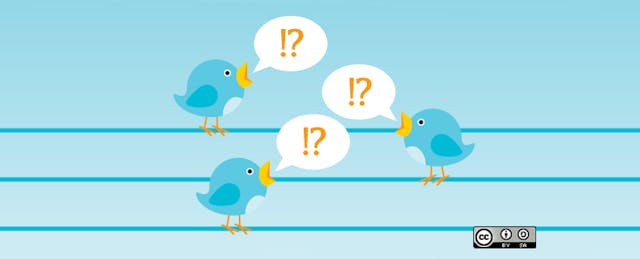When it comes to using social media in the classroom, educators on #EdTechChat are naturally a more predisposed group. (Join the conversation Monday nights from 8 to 9 pm EST.) As expected, they shared how much being a connected educator has broadened their professional lives--from developing a professional learning network to the specific classroom strategies they’ve found on social media.
One participant, Mr. Dreher (@Mr_Dreher) claims that “Twitter is much more convenient and effective than going to a teacher conference once a month,” and Shannon Degan (@shannondegan) shares that “2 months on Twitter has allowed me to meet more teachers in my county (85 buildings) than past 6 years.” Julie Nilsson Smith (@julnilsmith) offers this metaphor: “Twitter is a 24/7 river of professional development--you can approach it any time with a spoon or a bucket.”
Once the group moved past testimonials of the power of social media, co-moderators Susan Bearden, Sharon Plante, and I helped everyone dig in to discuss how social media should be used effectively in the classroom and how to encourage more colleagues to drink from the river. Bring out your buckets and spoons!
Deepen Classroom Conversations and Increase Communication
Many teachers maintained that adding social media conversations deepened academic dialogue in their classrooms. Shy students or students who need more time to pull together their thoughts speak more often when participating in online conversations than they do offline, according to many of the #EdTechChat teachers (and numerous research studies). As Tom Murray shares, “Social media is high interest for most students; collaboration, communication, and global connections are possible.” When students are working, social media can allow for robust conversations without disrupting the rest of the class (via Nathan Stevens). Some teachers encourage these kinds of conversations by making Facebook pages for each class, creating Twitter hashtags, or setting up backchannels during lectures or guest presentations.
Not surprisingly, social media also makes communication with students faster and more effective. For example, one participant, Dr. Justin Staub, says one of his students had just scheduled a makeup assignment via Twitter. There were a few shout outs for Remind 101 as a vehicle for communicating with students quickly and safely via social media. One favorite suggestion for communicating with parents came from Principal Ryan McLane (@McLane_Ryan) who has replaced print newsletters with video updates.
Model for Colleagues and Students
Modeling for students and colleagues is key. Staub stresses this: “Digital citizenship starts with modeling. I don’t tweet during class, but I let my students see me tweet in the hallway.” Joe Tita (@JoeTweeta) also suggests that educators need to “get comfortable using it themselves. It’s hard to see the value in it for class if you don’t use it yourself.” It’s more difficult to ask students to blog, for example, if the teacher has never blogged.
While it’s important to teach students safety online and be wary of consequences, it’s also important to share the benefits as well. Shawn Storm (@sstorm) argues that students “know the negatives--can’t get a job, get into good college, etc.” Instead, he focuses on “what tech CAN do for you,” like allowing them to learn and share globally. One astute comparison came from Staub: “Social media is the new forum, but the same concept, as was Socrates in Greece.”
Teach Balance
Balance is also important to model. Though social media is available 24/7, it doesn't mean that educators and students should be plugged in continuously. Frequent contributor Isaac Pineda (@Kairosedtech) points out that “just because you go to an ‘all you can eat’ place doesn’t mean you have to eat everything.” Students need help finding healthy levels of online engagement. They also need to learn how to separate their professional from their personal social media personas. Teachers are in the perfect position to model this for their students.
Barriers
Biggest barrier? Schools are still blocking access to many social media outlets. Fear of the unknown drives many of these decisions as well as outdated district policies. Tom Murray humorously sums up the issue: “Don’t make rules for the 2% of the knuckleheads.” A more complex barrier is a lack of experience or knowledge on how to use social media effectively for teaching and learning.
Choose Your Drink
Julie Nilsson Smith (@julnilsmith) shared that her response to “Twitter is boring” is “Then you’re following the wrong people!” Dr. Justin Staub has a slightly different response that also invites further conversation: “It’s okay that Twitter is boring,” but follows up by asking “What else are you doing to grow professionally?” The focus shifts from specific tools to how these tools provide professional development. Lyn Hilt (@lynhilt) also cautioned that we shouldn’t simply sell “our preferred choice of social media to other educators…because it might not be a good fit for them.” Dr. Justin Tarte (@justintarte) echoed this sentiment: “Some people tweet, some post, some pin…they are all tools, just like a pencil, laptop or tablet.” Educators need to find what works best for them.
What works for you?


